Best Cordless Router – Head-To-Head
Best Cordless 18-Volt Router
Advantages of a Cordless Router
As a carpenter, I use a compact router to make my own window sills when trimming windows, easing edges on decking and trim, creating chamfers, installing built-ins, mortising hinges, and sometimes to make on-the-spot moldings. More and more contractors are cutting the cord on their job sites and the ability for a cordless router to move freely around a job site is a huge plus.
Smaller routers, like these cordless routers, are useful in applications such as:
- Duplicating parts
- Cutting hinge mortises
- Profiling edges
- Cleaning veneer
- Trimming shelf lipping
- Flush cutting plugs
- Cutting joinery
- Sign making
- Mortising inlays
- Making small moldings
Best Cordless Router – Lineup
For this Head-to-Head evaluation, five cordless routers were selected. In order to keep the tools in this Head-to-Head somewhat similar, each manufacturer was asked to provide a router and 6.0 Ah battery. The following cordless routers were included in the test:
- DEWALT
- Makita
- Milwaukee
- RIDGID
- Ryobi
DEWALT DCW600 18-Volt Cordless Router
- Collet: 1/4″
- No Load Speed: 16,000 – 25,500 RPM
- Battery: 18V (20V MAX)
- Width: 3-3/4″
- Length: 5-1/8″
- Height: 11-1/4″
- Weight: 3lbs, 6.8 oz [bare tool]
- Variable Speed: yes
- LED light: Yes
- Plunge Capacity : 1-9/16″
- DEWALT DCW600
Makita XTR01 18-Volt Cordless Router
- Collet: 1/4″
- No Load Speed: 10,000 – 30,000 RPM
- Battery: 18V
- Width: 3-1/4″
- Length: 5-1/4″
- Height: 10-1/8″
- Weight: 3 lb 1.8 oz [bare tool]
- Variable Speed: yes
- LED light: Yes
- Makita XTRo1
Milwaukee 2723-20 18-Volt Cordless Router
- Collet: 1/4″
- No Load Speed: 10,000 – 31,000 RPM
- Battery: 18V
- Width: 3-3/4″
- Length: 5-1/2″
- Height: 10-3/4″
- Weight: 2lb 15.4 oz [bare tool]
- Variable Speed: yes
- LED light: Yes
- Milwaukee 2723-20
RIDGID R860443B 18-Volt Cordless Router
- Collet: 1/4″
- No Load Speed: 17,000-25,000 RPM
- Battery: 18V
- Width: 3-1/4″
- Length: 5-1/2″
- Height: 10-1/8″
- Weight: 2lb 6.6 oz [bare tool]
- Variable Speed: yes
- LED light: Yes
- RIDGID R86044
Ryobi P601 18-Volt Cordless Router
- Collet: 1/4″
- No Load Speed: 29,000 RPM
- Battery: 18V
- Width: 3-1/4″
- Length: 5-3/4″
- Height: 11″
- Weight: 2lb 12.8oz [bare tool]
- Variable Speed: yes
- LED light: Yes
- Ryobi P601
Cordless Router Performance Evaluations
The challenge for any Head-to-Head test is developing the testing and evaluation criteria in order to create a valuable comparison for users. Two relative, measurable comparison tests were performed: performance and run-time. These tests will give you an excellent baseline on overall tool performance.
In addition to the performance evaluations, each of the crew members spent time using the routers in order to evaluate them independently. The performance evaluations and these additional factors were used to determine the Best Cordless Router. All of the factors compared included:
- Features – an overall comparison of features and specifications.
- Ergonomics – Ergonomics is really important to users and an important category to consider when purchasing any power tool. In addition to traditional ergonomics, we also included functionality in this category.
- Performance – The performance evaluation took a very deep dive into router motors and how fast cut a dado into AC plywood.
- Run time – The run-time evaluation proves the user with a good baseline of expected work per battery charge. We use 1/2 round router bits to come up with a linear foot length and compute that to carpenter speak of “number of window sills” routed.
- Price – Price is always an important factor in determining which router is best for a user. We’ve included the current pricing found online for each of the routers at the time of publication.
Rockler Woodworking Router Bits
Rockler Woodworking provided the bits for this testing. All the bits performed well and we greatly appreciate Rockler Woodworking for the help. The bits used for the testing were:
- Five 3/8″ round-over/beading bits for the window sill run-time test
- Five 31/64″ (1/2″ plywood) dado bits for the performance testing
“Hey! This round-over bit comes with a beading bearing, sweet!” -Ethan
Best Cordless Router Features
WINNER – DEWALT
There were a few stand-out features that affect performance and safety. Each tool was ranked, using a 1 thru 5 scores, 1 being the best, to determine the tool with the best feature ranking. A list of some of them is included below.
The DEWALT barely took first place coming in at 12-points, just 1-point ahead of the Milwaukee. The Makita and RIDGID were third and fourth with 23 and 24-points respectively.
The DEWALT had a 1 or 2 score in almost every category, except the base plate.
| MAKE | Switches | Variable Speed Adjust | Depth Adjust | LED Light | Collet Spindle Lock | Elec. Brake | Base Plate | TOTAL | RANK |
|---|---|---|---|---|---|---|---|---|---|
| DEWALT | 2 | 1 | 2 | 2 | 1 | 1 | 3 | 12 | 1 |
| Milwaukee | 3 | 4 | 1 | 1 | 2 | 1 | 1 | 13 | 2 |
| Makita | 1 | 3 | 5 | 3 | 3 | 3 | 4 | 22 | 3 |
| RIDGID | 5 | 2 | 3 | 4 | 4 | 3 | 2 | 23 | 4 |
| Ryobi | 4 | 5 | 3 | 5 | 5 | 3 | 5 | 30 | 5 |
Power Switch
The best switches were the Makita, DEWALT, and Milwaukee in that order.
The Makita has a 2-step operation safety switch. The unlock button places to tool in standby mode [unlocks it] then the power button turns on the router. After turned off, and inactive for 10-seconds the tool locks again. As long as the LED lights are on you can operate the tool with the power switch. Once the LED light turns off, you need to press the unlock button first. This separate lock button may seem like a pain but is smart, it helps prevent the accidental start-up of the tool for user and work-piece protection. We’d like to see a longer time than a 10-second dwell.
The RIDGID router has a pull-out switch, in order to turn on and turn off the tool. This switch is awkward to use and not intuitive to use.
Switch placement was also considered and the routers that had an ambidextrous switch placement fared better. For example the Makita and Ryobi switch placement is on the front and rear of the tool respectively. The DEWALT and the Milwaukee and more geared to high handed user.
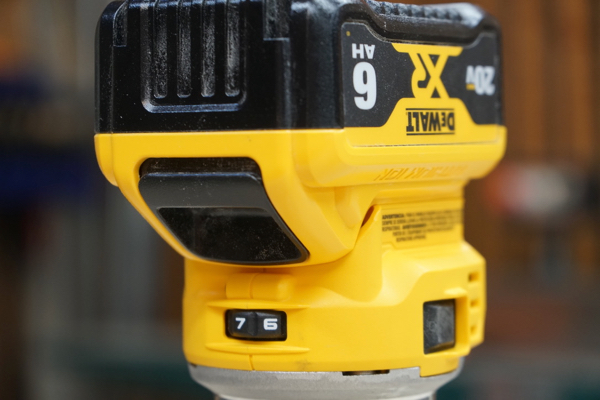
Variable Speed Adjustments
The DEWALT has the best variable speed dial adjustment, followed by the RIDGID and then Makita. DEWALT and RIDGID variable speed dials have an ambidextrous setup, located on the backside of the tool. The Makita and Milwaukee are set up for right-handed users. As a right-handed user, the dial is perfectly placed for your thumb to adjust the tool while gripping it.
The Milwaukee variable speed dial knob has protruding ribs, for easy grip and use. The Makita speed dial is recessed, and difficult to find when using, but has the SMOOTHEST adjustment of all the routers tested.
Router Base Depth Adjustments
All routers have a quick-release lever, but they differ in style and quality on the micro and macro adjustments. For example, Makita uses a quick-release cam lever to adjust or remove the router base. But for micro-adjustments, they utilize a rack-and-pinion depth adjustment system. This adjustment is smooth, fast and super easy to use. There is some slop in this adjustment making micro-adjustments difficult. The aluminum housing of the router is etched and has easy-to-read Imperial and Metric depth scales.
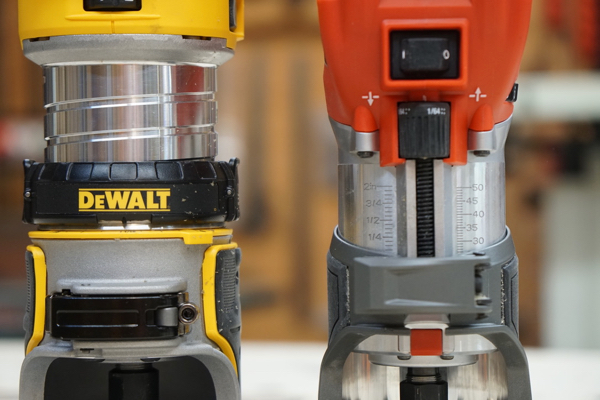
The best base adjustment of all the routers was the Milwaukee, utilizing a push-button macro adjustment and a dial for micro-adjustments. The micro screw adjustment knob on the Milwaukee is rubberized, is easy to grip and is precise and smooth to operate. The other routers were more difficult to adjust.
One really nice feature on the RIDGID and Ryobi routers is the micro-adjust dial for adjusting the depth of cut. The RIDGID quick release lever had to be adjusted by the team prior to testing, it was loose and not holding its adjustment.
The DEWALT is precise and has a screw adjust using a thread-cut into the router housing barrel, called a “depth adjustment ring.” This ring is used for micro-adjustments but also the larger, macro adjust. Macro-adjusting is not as easy and requires the user to release the depth adjustment ring. We liked the precision of this adjustment ring, but not the slower speed.
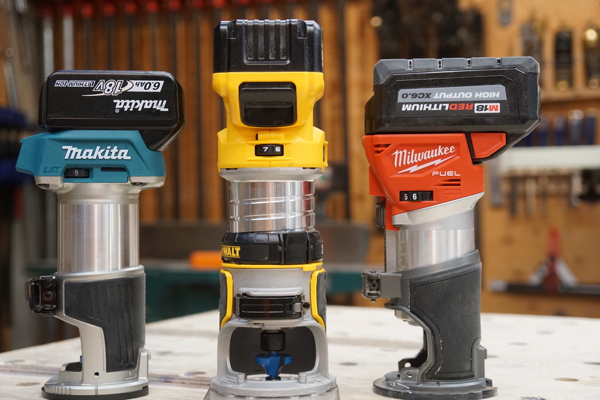
While setting up the DEWALT for run-time testing, we noticed that if you grip the tool high (by the depth adjustment ring) the tool came out of adjustment. We tightened the quick release lever but it still occurred. As a result, we had to be cognizant NOT to grip the router high. This is something DEWALT may want to look at, and something that we found annoying and a problem if you want to set this tool up as a window sill “set-and-forget,” tool.
RIDGID and Ryobi have identical mechanisms and easy to use. When utilizing the spring-loaded lever, macro adjustment, the base easily slides along the entire housing. The Micro adjustment is done via a screw and works well.
Stan – I LOVE the idea of a rack and pinion adjustment (Makita) but there is a definite backlash in its micro-adjustment.
LED Work light
All of the routers have at least one LED work light. The DEWALT, Makita and Milwaukee routers have two LEDs. The brightest light is the Milwaukee followed by the DEWALT and then Makita. All three of these router LEDs cast a shadow less light. The DEWALT LED work light stays on for 20 seconds after the tool is shut off, Milwaukee stays on for 15-seconds, Makita for 12-seconds.
That Milwaukee light could land the space shuttle ~ Jeff Deitz
Electric Brake
With regard to stopping the router bit, the DEWALT and Milwaukee stop the bit instantly when turned off. The other routers take a second or two to spin down. Electric brakes on routers is a huge safety feature.
Base Plate
The team liked the DEWALT 1/2 round and 1/2 square shape base plate. (See photo below), The DEWALT has the best general purpose base plate. The Milwaukee and RIDGID offer the best value, and come with two larger base plates for template bushing routing.
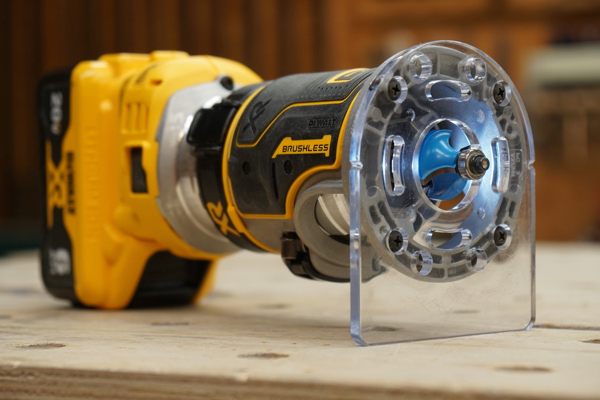
The Makita had the smallest base plate and was not as stable as the other router tested. When testing the Makita we found that our Rockler round-over bit was too big, and touched the sub-base plate. The reasoning for this is the Makita provides a sub-base plate designed and sized for template bushings.
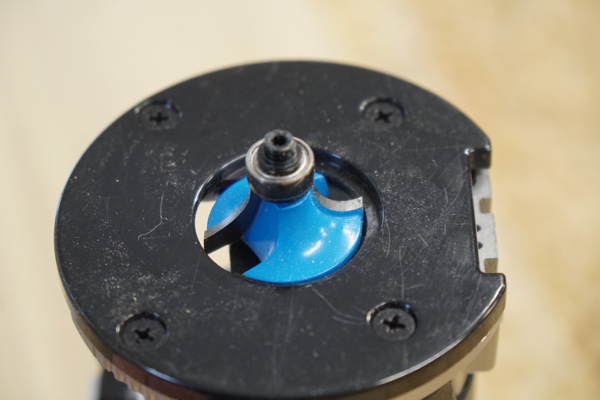
Template bushings are typically used with mortising hinge jigs. In order to use this Makita router, base and router bit, we had to turn on the router and cut through the base-plate with the bit.
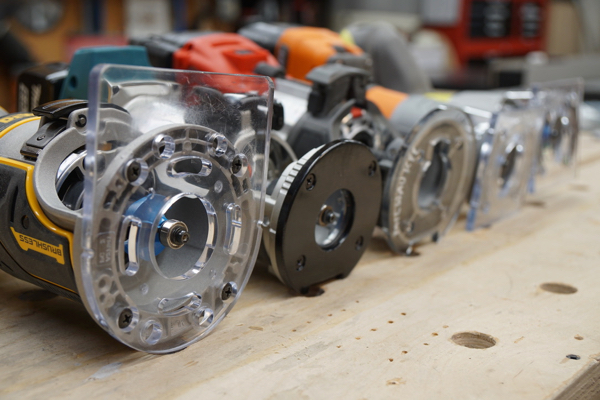
The Milwaukee router, includes a 5-3/4” sub-base plate with an opening sized for template bushings. The sub-base plate is perfect for mortising jigs or where more stability is desired. ~ Rob Robillard
We worked with many users in the field who would grab their full-size routers to mortise hinges specifically because they had wide sub-base plates. They were afraid that their compact routers would dip into the jig and ruin their cuts. Makita may want to supply a larger base with their router.
Best Cordless Router Ergonomics
WINNER – Milwaukee
Ergonomics is the science of designing and producing tools that improve a worker’s efficiency while reducing discomfort, fatigue, and risk of injury. Ergonomically enhanced tools can include helpful features such as rubber oversold, ambidextrous switches, and increased line of sight. Whether you’re shopping for ergonomic tools or just trying to select the right one for the job from an existing collection, the key things to consider are whether or not the tool eases your work and prevents you from straining in ways that could lead to injury.
| MAKE | Grip | Weight / Balance | Ease Of Bit Change | Power Switch Usability | Ease Of Depth Adjustment | Line of Sight | Total | Rank |
|---|---|---|---|---|---|---|---|---|
| Milwaukee | 1 | 3 | 2 | 3 | 1 | 2 | 12 | 1 |
| DEWALT | 3 | 5 | 1 | 2 | 2 | 1 | 14 | 2 |
| Makita | 2 | 4 | 3 | 1 | 5 | 3 | 18 | 3 |
| RIDGID | 4 | 1 | 4 | 5 | 3 | 4 | 21 | 4 |
| Ryobi | 5 | 2 | 5 | 4 | 4 | 5 | 25 | 5 |
The Milwaukee scored 1 and 2 in every category except the weight and usability of the power switch and came in first place with 12-points. It is a VERY comfortable too to use for long periods. Following in second place was the DEWALT with 14 points and Makita with 18 points.
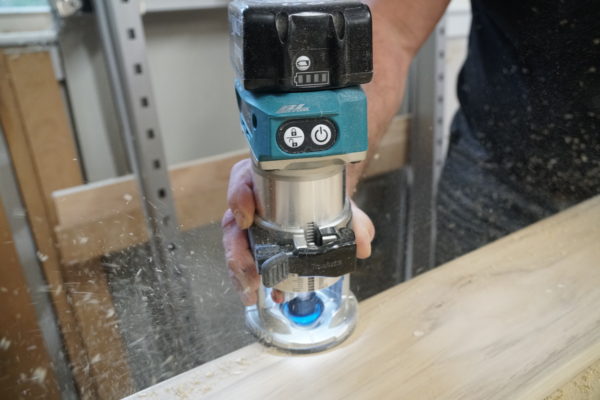
Grip
You may not pay much attention to grip, but if you’re mass-producing stock for a project, grip matters! The best router grip was the Milwaukee with its full rubberized coverage. The second was the Makita. Both of these two designs are of similar size and seem to have found a sweet spot in grip oversold and diameter.
The Ryobi also has a comfortable grip but it is a super bulky and top-heavy router, with its stem pack battery. The DEWALT router has a large barrel resulting in a less comfortable grip that causes fatigue over time.
This router [Makita] fits the best in my hand ~ Rob Robillard
Weight
The lightest router [bare tool] is the RIDGID followed by the Ryobi. When the Ryobi has a 6.oAh stem-pack battery attached it is 11″ tall – the second tallest router in the pack, second only to DEWALT at 11-1/4″.
Weight in this test related directly to size as well. The DEWALT is the thickest diameter router and also the heaviest. Users with larger hands may find the DEWALT comfortable, but we found the grip diameter too big.
Ease of Bit Change
When changing out the router bit you need to engage a spindle lock and rotate the spindle shaft to engage the lock. The DEWALT has the best spindle lock. The DEWALT has 12 indents that easily and quickly lock in every direction. This spindle lock also allows the user to tighten or loosen through ratcheting the collet with a wrench.
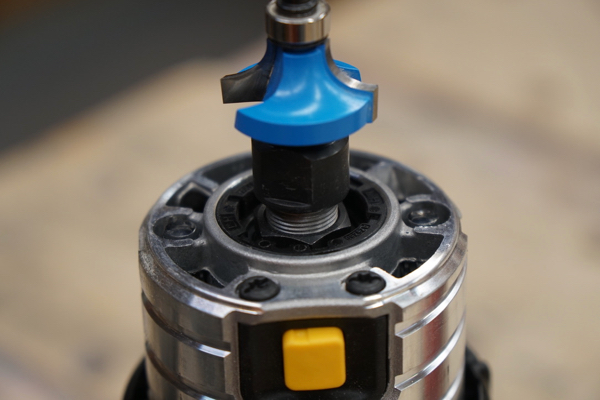
Milwaukee has 6 spindle lock positions. The other three routers have cut out holes in the shaft, that allow 2-positions (180 degrees to engage spindle lock). With regard to the actual spindle lock button, the Makita has a superior collet button over the others.
Ease of Adjusting Depth of Cut
Ergonomically speaking the easiest base adjustment of all the routers was the Milwaukee, utilizing a push-button macro adjustment and a dial for micro-adjustments. The rubberized knob is easy to grip, adjust and precise.
Line of Sight
It is no secret that the routers with the larger base opening provided a better line of sight. The DEWALT and Milwaukee both have the largest base opening at 2-5/8″ and 2-1/2″ respectively. The larger opening and strong LED light help provide the best line of sight.
Router Housing – Fit and Finish
Fit and Finish was not scored but does show through in the total Head-to-Head scoring. DEWALT, Makita, and Milwaukee all have durable aluminum router housings, the RIDGID and Ryobi have plastic housings. Better quality construction, materials, seams, and adjustments show thorough here.
One thing we noticed was that unlike the others the Ryobi housing is completely sealed at the router collet. This design means the Ryobi cannot blow away the sawdust. We question whether the lack of cooling vents will have long-term impacts on the tool longevity. We spoke to Ryobi and they’ve zero problem with overheating or returns due to heat.
Cordless Router Run-time Test Procedure
In order to simulate a real carpentry application for our run-time testing, a window sill routing procedure was used. This is an application that relates directly to trim carpenters in the field. A 3/8″ round-over bit and bearing was used to rout two sides of a seven-foot Poplar board.
Testing Procedure:
- Each router received a new Rockler 3/8″ round-over bit
- A brass “set-up bar” was used to set the depth of the bits
- Each router used a fully-charged 6.0 Ah battery
- All routers were sent to their highest speed
- A 1-2 second per foot, feed-rate was used
- 7-feet of the board was routed on 4-edges
- Rest tool while rotating the board and ripping edges off
- Repeat until unable to complete procedure
This was an aggressive test for these routers but realistic if a carpenter was to mass-produce all the window sills needed for a large house.
Cordless Router – Run-Time Test Results
Winner – DEWALT
During this test over 3500 linear feet of Poplar was used. The DEWALT cordless router came in first place blowing away the competition by routing 472.5 linear feet which equals 157.5 three-foot window sills or a bit under 1/10 of a mile.
I think the DEWALT did more steps today than I did. -Ethan
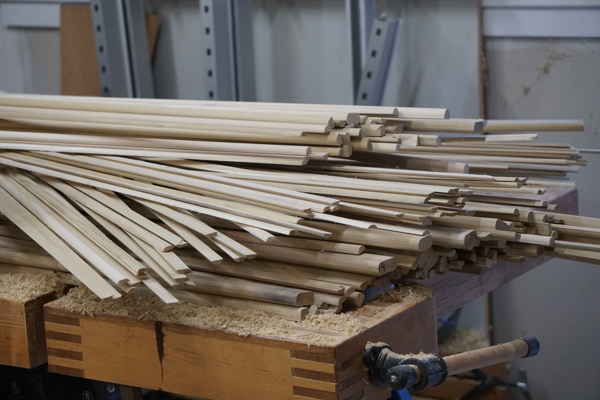
** 1750 LF of “Window-Sill” – 3/4″ Round Poplar Nosing
Second place was the RIDGID with 364 linear feet [equaling 121 window sills] and third place was the Makita routing 318.5 linear feet [equaling 106 window sills]
We noticed that the DEWALT and Milwaukee plowed through the material with ease while the Makita was slower cutting. The RIDGID router was also slower cutting and had noticeably more vibration than DEWALT, Makita, and Milwaukee. The Ryobi router felt similar to the RIDGID in terms of vibration but also felt more top-heavy than the other tools probably due to the size and weight of the Ryobi battery pack.
| RUNTIME TEST | # 1/2-Round Routed Strips | Rips | Linear Feet | # of 36" Window Sills | Rank |
|---|---|---|---|---|---|
| Dewalt | 135 | 67.5 | 472.5 | 157.5 | 1 |
| Ridgid | 104 | 52 | 364 | 121 | 2 |
| Makita | 91 | 45.5 | 318.5 | 106 | 3 |
| Milwaukee | 88 | 44 | 308 | 103 | 4 |
| Ryobi | 84 | 42 | 294 | 98 | 5 |
Cordless Router Performance Test Procedure
To determine the relative performance of the individual routers a test rig was used to keep all of the variables as similar as possible. This test shows that the router with the highest performance removes the plywood material faster than the other, slower machines. The time was recorded for each router to complete 14 cuts. This test is less about speed and more about the power of each router.
In order to simulate a real carpentry application for our run-time testing. A dado routing procedure was used. A 31/64″ (1/2″ plywood) dado bit was used to cut a 0.10″ deep dado in AC plywood.
Testing Procedure:
- A new 31/64″ (1/2″ plywood) Rockler two-wing carbide dado bit was used on each router.
- A fully charged, 6.0 Ah battery was used for each test.
- The same sheet of 3/4″ AC plywood provided all 5 pieces used for the 14 cuts.
- A CNC router station ensured constant dimension and auto-setting the depth of cut to zero and then dialing in the same 0.10″ cut depth before the trial for any given router. [Control cut depth tolerance of .001″ using the Mach 3 software]
- An equal force was applied to each router through the same gravity load to pull the gantry of the CNC router with the same force through a system of pulleys and consistent weights.
- All routers operated at their fastest RPM setting.
- The amount of time that it takes each router to plunge through the plywood material over 14 individual cuts were recorded.
Cordless Router Performance Test Results
Winner – DEWALT
AC plywood was used for these tests. Carpenters often use AC plywood to make plywood boxes or shelves and the bits used are designed to make plywood-sized dado or rabbit cuts. The Performance Test was run multiple times in order to even out the differences in the density of the individual pieces of plywood. The test was performed seven times in the rough “C” side of the plywood and then run seven more times on the “A” side of the plywood.

Observations made showed the times in the “C” side of the plywood was consistently faster than the times in the “A” side. This result was true for all routers that completed the Performance Test. We assume that the “C” side contains less dense sets of plys than those used on the “A” side. The difference between the two sides of the plywood is shown in the following graph. The “A” side of the plywood cuts was the 8th through the 14th cuts.
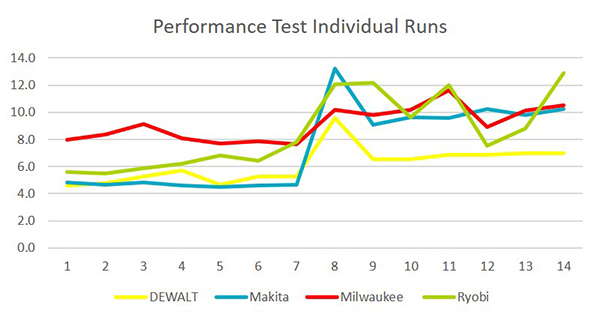
One clear surprise was the performance of the RIDGID router in the Performance Test. The RIDGID router only cut a 4-3/4″ long dado into the 48” material on the first attempt. On the second attempt, the RIDGID only cut a 3-5/8” long dado. As a result, we declared the RIDGID as a DNF (Did Not Finish) on the Performance Test.
Note: RIDGID did not complete the Performance Test.
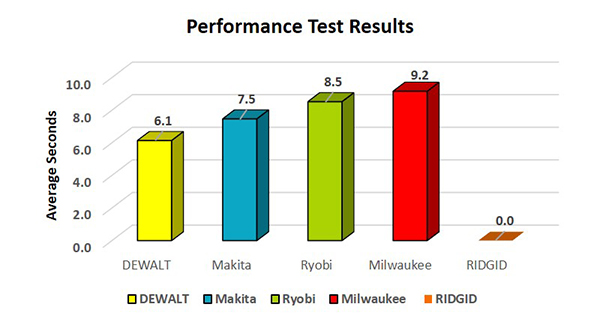
The DEWALT router was the clear winner of the Performance Test. Its average time of 6.1 seconds to cut a dado into a 48” piece of AC plywood was almost 25% faster than the runner-up. Makita was second with an average time of 7.5 seconds. Ryobi and Milwaukee finished with times of 8.5 and 9.2 seconds, respectively.
The Performance Test puts the routers through their paces because the router bit is relatively good-sized in diameter and both sides and the bottom of the bit is cutting material at all times. This is in contrast to cutting with a round-over bit that has one cutting surface at a time engaged with the material for only about 90 degrees of the bit rotation, The winning router is the one that removes the most material in the least amount of time. A logical conclusion might be to bet on the router with the highest RPM, given that it has more cuts per unit of time, right?
The Milwaukee router has the highest unloaded RPM rating at 31,000 RPM but placed 4th out of 4 routers.
The DEWALT has almost the slowest unloaded RPM rating at 25,500 RPM but won the Performance Test.
The combination of rotational speed coupled with the highest delivered torque is what wins this test. The following bullet list shows the unloaded RPM rating for the tested routers.
| MAKE | RPM [No Load] |
|---|---|
| DEWALT | 16,000 - 25,500 |
| Makita | 10,000 - 30,000 |
| Milwaukee | 10,000 - 31,000 |
| RIDGID | 17,000 - 25,000 |
| Ryobi | 29,000 |
Winner: Makita [Best Value]
The Makita router is tied for second-lowest price in the test but comes out near the top in testing. This router was a no-brainer selection and is a great value. Pricing is a key part of the purchasing mix, and it’s crucial that you get it right in order to determine the Best 18 Volt cordless router. For this Head-to-Head we looked at bare-tool pricing to eliminate discrepancies in the composition of the kits provided by different manufacturers.
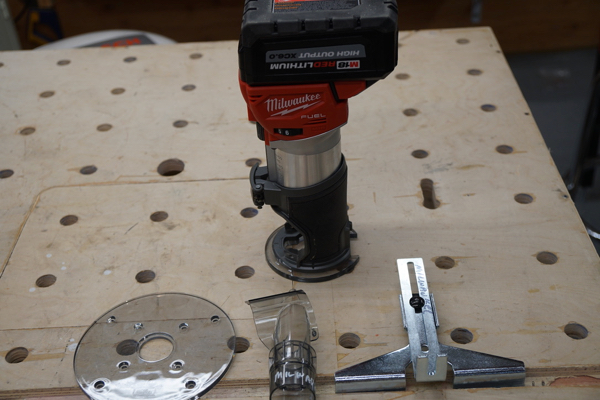
One interesting thing about the Milwaukee [bare tool] is that it comes with some [value added] accessories, clearly, they were thinking of their users and common applications. The bare tool accessories are:
- Dust Shroud
- Straight Edge Guide – fits common jigs without dipping [e.g. hinge jig]
- Larger 5-3/4” sub-base plate with an opening sized for template bushings,
The Makita cordless router [bare tool] is a mirror image of the corded RT0701C 1-1/4 HP corded Compact Router. That means that all the expensive accessories, like plunge bases, tilt bases, guides and dust shrouds, that users already own, will fit the cordless router. That’s not only smart but a nice thing to do. Clearly Makita is thinking about its tool users and making the transition to go cordless more cost-effective and cheaper.
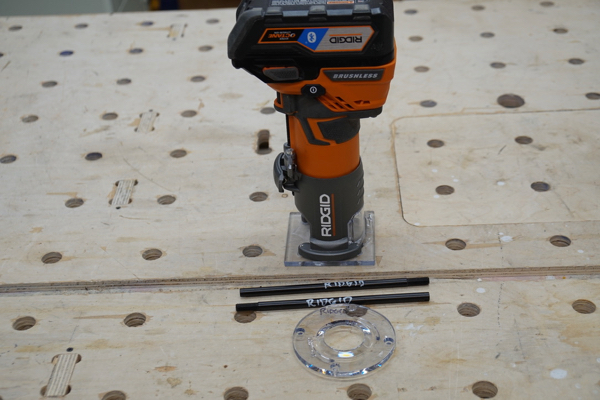
The RIDGID router comes [bare tool] with a straight edge set up, larger rounded sub-base plate with an opening sized for template bushings and a storage bag.
Below is a table showing the pricing (at the time of publication) of each tool:
| MAKE | Price [bare tool] | Rank |
|---|---|---|
| Ryobi | $ 69.00 | 1 |
| Makita | $ 129.00 | 2 |
| Ridgid | $ 129.00 | 3 |
| Milwaukee | $ 179.00 | 4 |
| Dewalt | $ 199.00 | 5 |
Buy Now From Our Sponsored Retailers
Other Options
Best In Class Cordless Router
Winner – DEWALT
The old advertisement from Virginia Slims said it best, “You’ve come a long way, baby.”
The fact that we now have a choice in cordless trim routers that are real workhorses is great for the industry. Our overall winner, the DEWALT DCW600 carved up almost 1/5 of a mile of rounded-over trim on one 6.0 amp-hr battery charge! The DEWALT took first place with a ranked score of 9 points.
| Performance Test | Runtime Test | Ergonomics Ranking | Price | Total Ranked Score | |
|---|---|---|---|---|---|
| Dewalt | 1 | 1 | 2 | 5 | 9 |
| Makita | 2 | 3 | 3 | 2 | 10 |
| Milwaukee | 4 | 4 | 1 | 4 | 13 |
| Ridgid | 5 | 2 | 4 | 3 | 14 |
| Ryobi | 3 | 5 | 5 | 1 | 14 |
The Makita XTR01Z router, is a great value, and was a smooth and precise unit. It took second place with a score of 10 points, right on the heels of DEWALT.
The new Milwaukee 2723-20 came in third with a score of 13. It won the ergonomics category and was a strong finisher in the other tests, as well. The RIDGID and Ryobi routers certainly held their own in this competition with impressive runtimes and power respectively.
Overall, we saw a series of tools that performed in the same league as their corded trim router counterparts. The bottom line, these routers consistently performed as well as its corded version, but without the cord! That alone is enough for me to make the transition. The fact that we now have a compact and powerful cordless router to work with is huge.

Best Cordless Router Video Review
About the author
23 Comments
Leave a comment
Disclosure
Product reviews on this site contain our opinion of a product or service. We will always strive for objectivity and transparency in our reviews. Our goal is to provide readers with honest, objective information based on our own experiences. We never have and never will accept payment in exchange for a positive review. Many of the products that we review are provided to us for free by a manufacturer or retailer. In some cases, we also have advertising or affiliate relationships with manufacturers and retailers of products and services we review. For additional information please visit our additional disclosure policies.











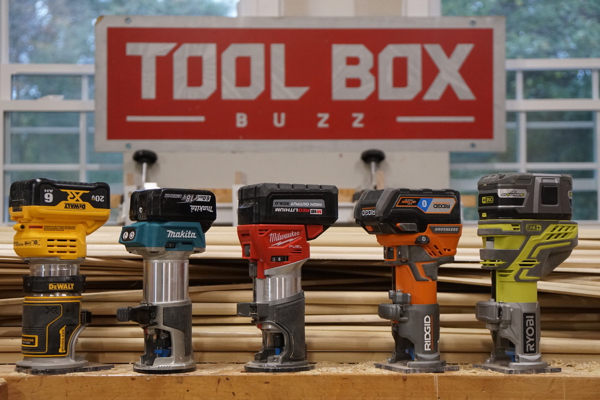
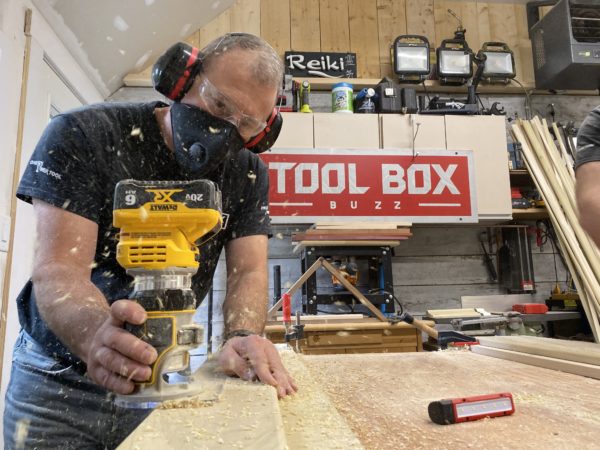
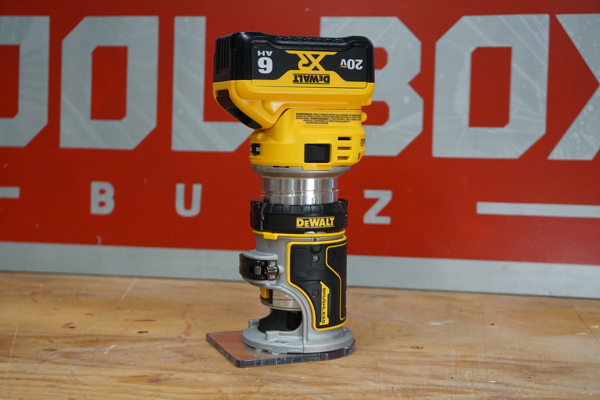
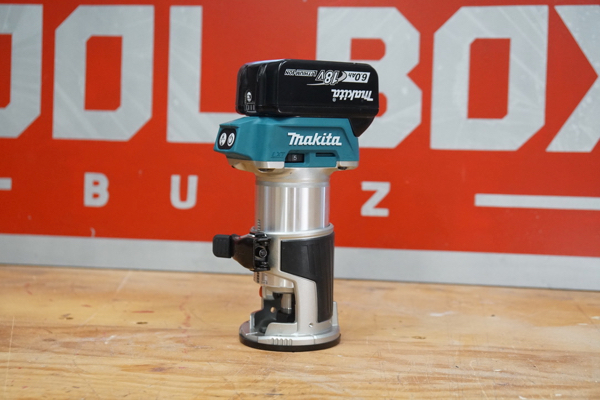
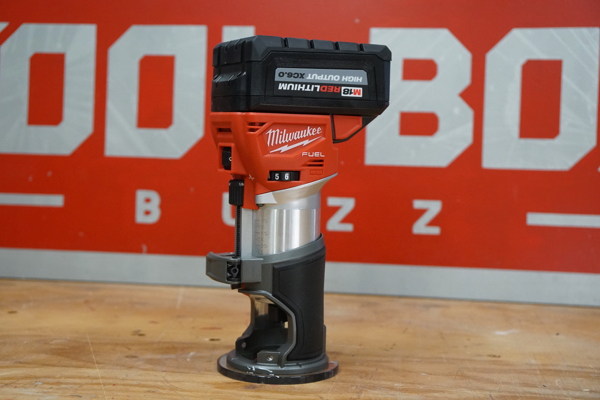
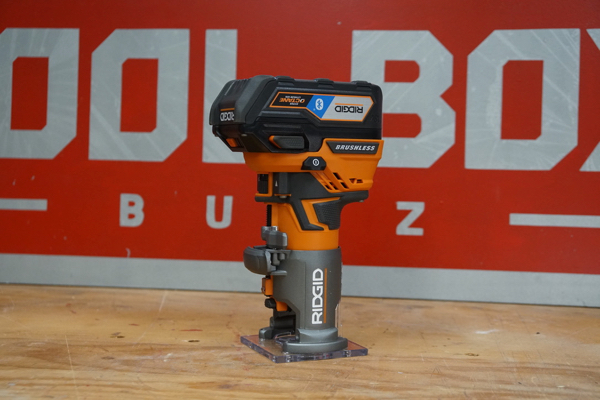
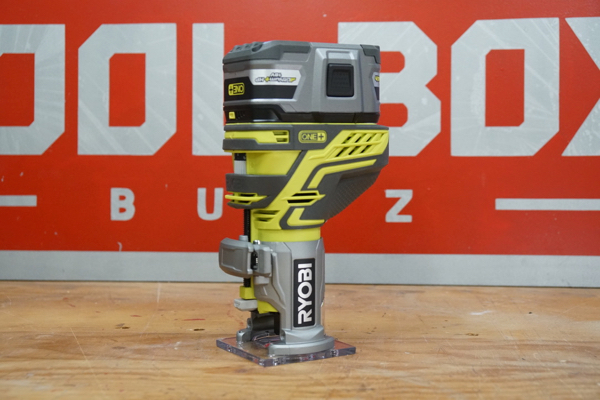
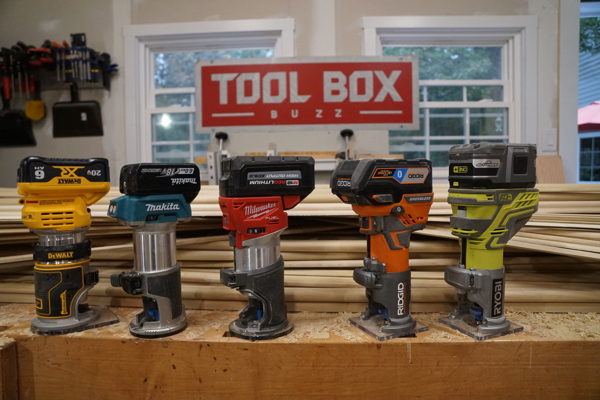
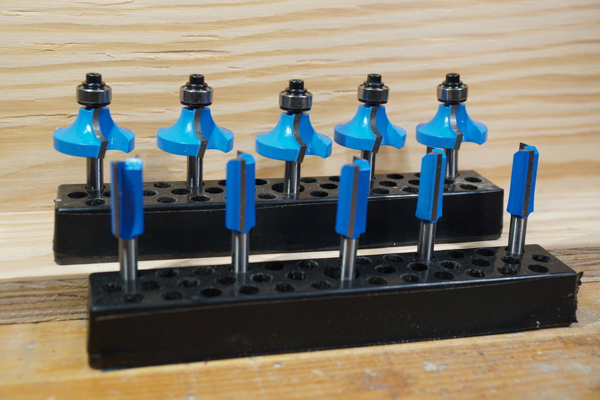
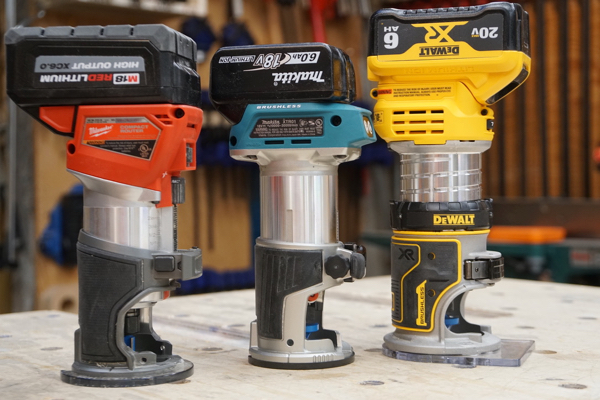
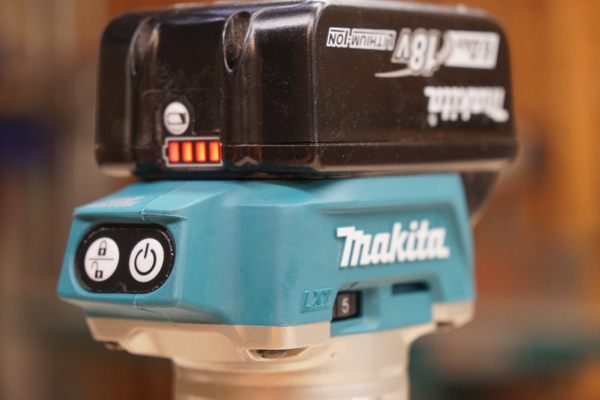
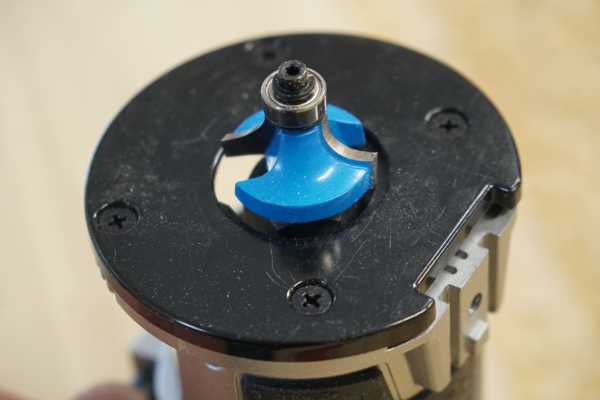
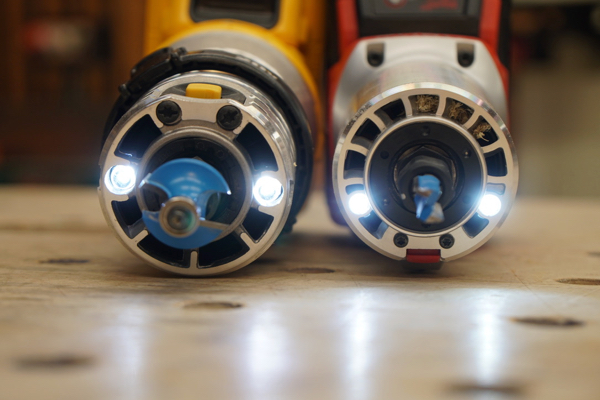
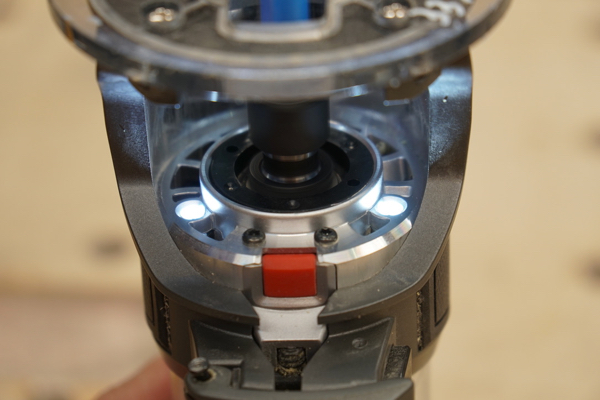
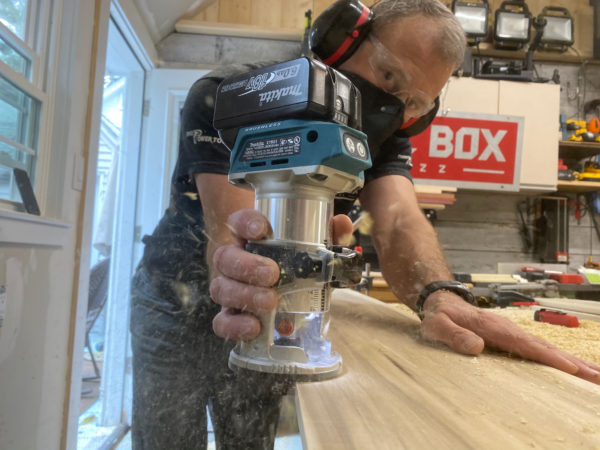
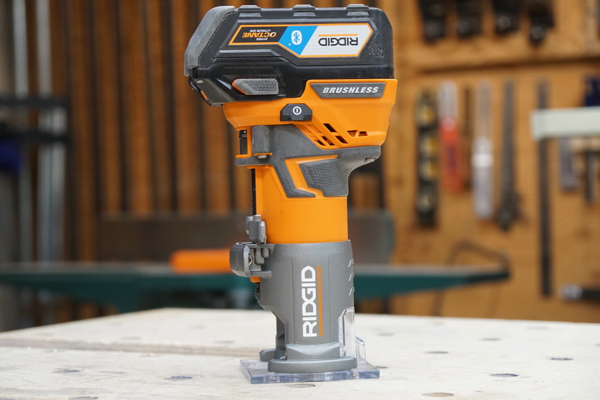
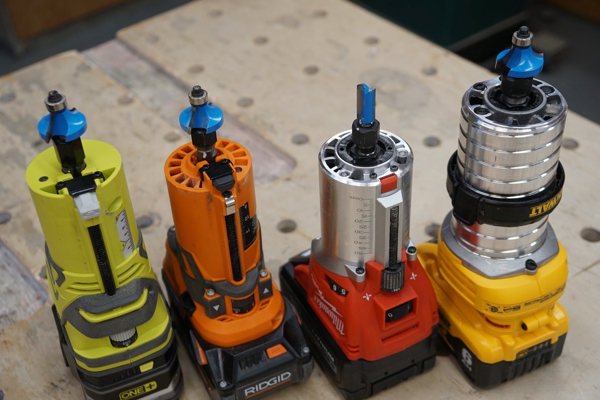
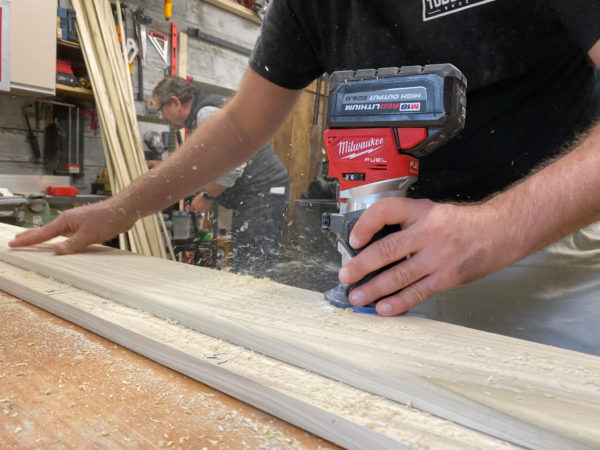
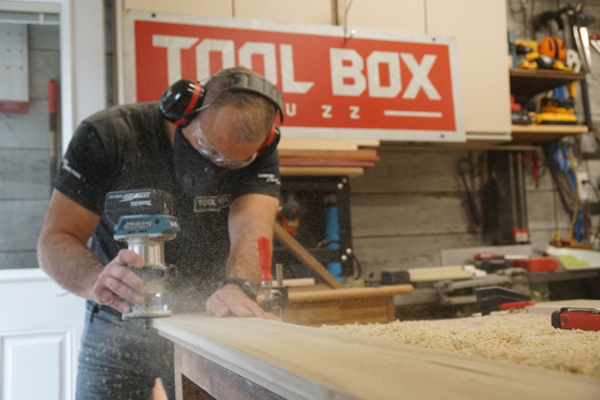
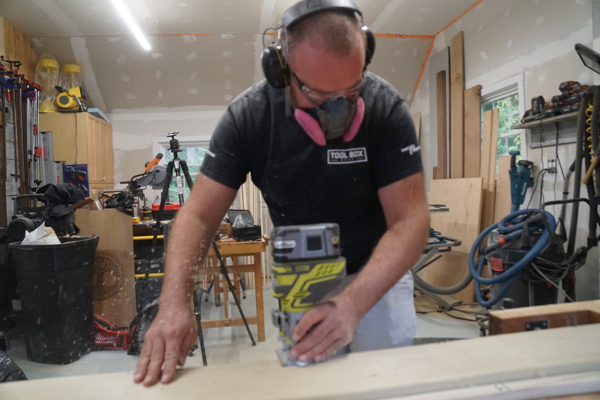
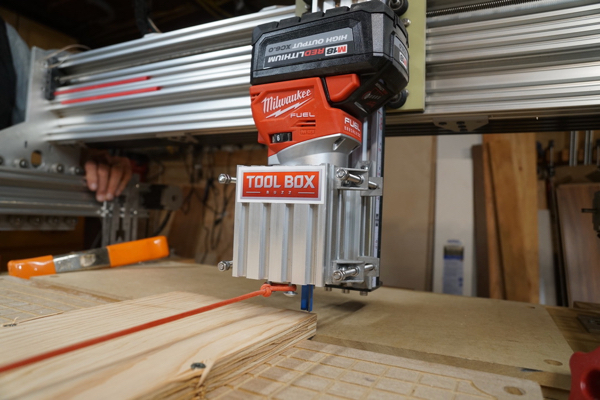
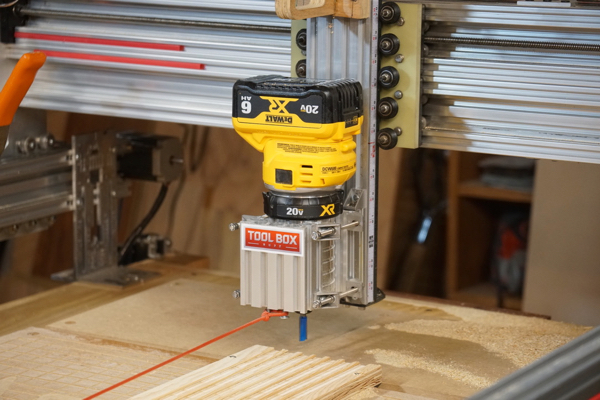
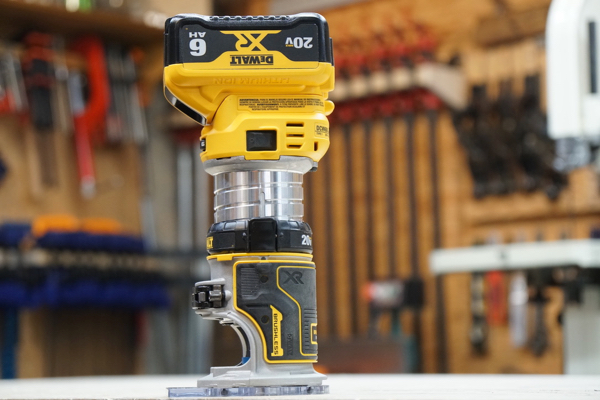












Excellent testing.
There is one consideration on the DeWalt that bears mention. Like the Makita, the DeWalt shares form factor with it’s corded stablemate. Which means that the range of bases and accessories is common. Very important consideration for me, as I’ve got cordless tools in both the Makita and DeWalt 18v platforms, but I already have the DeWalt compact corded router with plunge base.
And that, I think, leads us to what would have been a useful additional test. Cordless router used in a plunge base. This would, to my mind, be dependent on the ergonomics and indicate how the top heaviness of a cordless plays into plunge use, and whether there’s any meaningful differences in plunge use between the contestants.
(BTW, at the time of this comment, the DeWalt can be purchased as a bare tool with a free 5ah battery.)
How could a router be declared the best if it cannot hold its height adjustment when in use ? Is this not critical if not dangerous ? How could available accessories not be considered, they are routers these affect its use ability.
ALL of the routers have flaws or items that could be improved. We tightened the lever on the router but did not “crank” on it, for fear of damaging it and losing it for our testing. It’s very possible that the lever tightening can deal with this minor issue.
We routed almost 500 liner feet at one time. The router has a grip section – and we recommend keeping your hand on that grip.
Feel free to use the data we provided and rerank the routers to suit your needs. Appreciate the feedback, stay well! ROB
Interesting. I have the Makita, have been using it for a year, and love it. First thing I did was put an after market base on it though (woodhaven, $25). As was noted here, the original base is just about useless.
Dust collection on the makita is excellent when the vac connection is put on. I use the M18 shop vac to extract, and it’s great to not get a faceful of router shavings when routing jambs in place (for timing reasons I often build jambs myself and put them in before doors are ordered, to keep moving on trim. And because I hate finger jointed jambs)
The key question is given I love m18 for the most part so far, and it has become my jobsite line while the makita is the shop line, am I going to want to buy the Milwaukee? I grant as a practical matter one discount and I’ll be unable to resist.
I do think dust collection on jobsite is relevant these days and belongs in reviews. I’m putting more and more time and money into it, including running temped ceiling mount air filters during the day.
It’s a little difficult to tell but it does not appear the opening of the Dewalt (for line of sight) is larger than the Milwaukee? Is this a typo? Thanks Just wondering…
Dewalt is slightly larger than the Milwaukee
You mention that the “The DEWALT had a 1 or 2 score in almost every category, except the base plate,” but then go on to state that the baseplate is fine. “The team liked the DEWALT 1/2 round and 1/2 square shape base plate. (See photo below), The DEWALT has the best general purpose base plate.”
Not sure why it got a mid pack score if it has the best general purpose base plate. Can you elaborate on this please? (and thanks).
The team liked the DEWALT 1/2 round and 1/2 square shape base plate. The DEWALT was the best general purpose base plate. However, both Milwaukee and RIDGID offered better value, and come with two plates total. One smaller, and one larger base plate for template bushing routing. As a result the team scored them higher in this particular ranking.
Thanks for the clarification!
Regarding the small sub-base hole on the Makita, if you have the tilt base, you can remove the square, slotted plate and swap it for the round one. Not sure if this affects safety or performance (not tested yet), but larger bits fit through the aperture.
from the data you posted, I would rank milwaukee as #1 cause you are weighing all features equally. your data is skewed between dewalt and milwaukee on variable speed adjustment, which i would say should not have the same importance as depth adjustment. Your simple arithmetic logic is useless when determining the best cordless router.
Comments like this are useless…where else can you get FREE content like this, with all the data so you, the perfect mathematician can do your own ranking. Guys like you make me wonder WHY we put forth so much effort on these.
That is hilarious! Most the time you don’t see the author respond to this kind of ignorance, it’s usually just ignored or deleted. I’m glad to see the way you completely rebutted his response with his own words that was great!
I do find that in various reviews on this site certain things
are not scored how I would after reading the expanded explanation,
but without the information I wouldnt even know.
One thing I was curious about was with the makota on the plywood run test was the noticeable spkie because of their energy star system as it was engaging?
Adam – That’s an interesting point, possibly true. Today all of these brushless tools have so much electronic control that it’s hard to figure out some of the performance differences between brands.
This ended up in my mailbox for some reason, so I’ll post a followup. I bought the Milwaukee m18 router and really like it. Do I like it better than the Makita? No clue really, because both are excellent little trim routers and neither has annoyed me. I’ve switched to m18 for jobsite, makita for shop (because across the board m18 is currently a better platform, but those “issues” don’t come up in the shop)
The Milwaukee base hasn’t made me immediately want to run out and buy an aftermarket base immediately, so it has that advantage.
The real loser is my Colt, which hasn’t been out of it’s box in over a year.
I would like to thank you for the enormous time and effort your team put into this review. I most certainly am not your usual wood worker having never used a Router. Unfortunately, and fortunately my fishing days are mostly behind having been sidelined by age and ailments. Woodworking has always been an interest so I have been gearing up with a Makita XSR01 (Yes, and thanks I saw the Video!). I am not picking #1 since your review had so much in it, I had to simplify. For me it came down to Blue or Red. The Milwaukee with good adjustments favored Righties, I don’t do windows and I had batteries (duh) and it might help me vote. I liked that your review did not just say “Buy X or Y”. It made you think. Perhaps a little too much for one reviewer. It offered enough to “Cherry Pick” for needs and not feel like I should have got the other one. And mostly, importantly, it should put a good tool in the hands of a hardworking man.
Wow, this is super comprehensive. I feel like I just used each of these tools, ha. Thanks for the detailed information and really appreciate the ‘little’ things to watch out for.
Rob, if you ever do another router h2h, it would be super dope to look at the accuracy/repeatability of their depth adjustments. Every trim router I’ve had, including a few from this test, has been pretty poor when it comes to setting a depth and forgetting it. They all eventually start slipping down and digging deeper into the material, even after tightening down the relevant screws/clamps/etc. If I’m routing a groove in 10x 4′ boards, I’ll be cutting 1/4″ deeper by the last board for sure if not careful. I’m currently using the Milwaukee and I’ve started just keeping a finger over the screw knob if I’m doing an important cut.
Great feedback thanks David!
Unfortunately, you said virtually nothing about dust collection, especially for a tool that make a lot of it!
i love the way this team works and takes the time to do these videos as i am sure it takes alot of resources and time to put these together, i njoy every video and look forward to more and more as i use these videos to help decide on what to buy…
Thank you for the thorough testing and detail documentation of the various routers. If you look at the categories, you could probably have weighted categories to really stress importance on one vs the other. Some may not see Price as critical such as Usability or Features. May change the winner of the article.
Sam – This is why we publish all the results, so everyone can make their own final ranking depending on what matters most to them 🙂